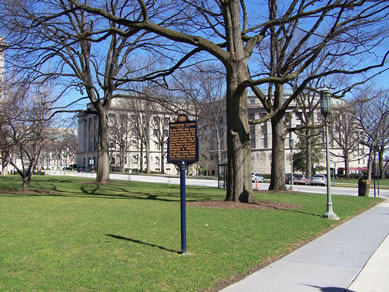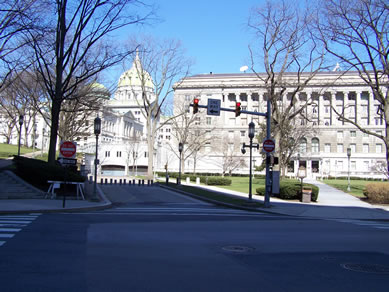Harrisburg on the eve
of Civil War
Study Areas
Tanner's Alley Neighborhood
Harrisburg, Pennsylvania
Although Tanner's Alley was only a single street, barely two blocks long, it has come to represent the entire African American community in this mixed-race neighborhood. This area east of Capitol Hill and north of Walnut was not laid out into streets by William Maclay, and was undeveloped until the borough added the substantial parcel of land known as Maclaysburg in 1838. At least one or more large tanneries operated here, restricted to the northern edge of town by the highly offensive odors they produced.
It was also an area pockmarked with sandpits and studded with piles of building materials from a dozen years of construction on Capitol Hill. Free African Americans from the countryside and fugitive slaves drawn to the free soil of Pennsylvania built shanties and established homes on this parcel of land in the shadow of the new Capitol. A sizable community already existed by 1825, as many of the rioters that confronted slave catchers at the Courthouse in April 1825 had come from this area.
In 1838 the borough added land north of South Street, and streets were officially laid out, including Tanner's Lane. In November 1839, the congregation of Wesley Union Church moved into a new brick church, built on land at the corner of Tanner's Lane and South Street that was purchased from the Forster family. When Wesley Union Church moved from its old and cramped log church building in Judys Town to the new location on Tanner's Lane, the social center of Harrisburg's African American community moved with it.
 Within
two decades the four densely-settled blocks bordered by North Fourth,
South, Short and Walnut streets contained Harrisburg's primary African
American neighborhood, with most of the African American residents
concentrated on tiny, muddy, Tanner's Alley. An African American Masonic
Hall was established here, William Jones moved to the neighborhood
and built boarding houses here, Frederick Douglass and William Lloyd
Garrison spoke at the Wesley Union Church in 1847, after being chased
by Harrisburg rowdies from the Courthouse, and Joseph Bustill settled
in this neighborhood in December 1855 to reorganize and revitalize
Harrisburg's flagging Underground Railroad operation.
Within
two decades the four densely-settled blocks bordered by North Fourth,
South, Short and Walnut streets contained Harrisburg's primary African
American neighborhood, with most of the African American residents
concentrated on tiny, muddy, Tanner's Alley. An African American Masonic
Hall was established here, William Jones moved to the neighborhood
and built boarding houses here, Frederick Douglass and William Lloyd
Garrison spoke at the Wesley Union Church in 1847, after being chased
by Harrisburg rowdies from the Courthouse, and Joseph Bustill settled
in this neighborhood in December 1855 to reorganize and revitalize
Harrisburg's flagging Underground Railroad operation.
This same neighborhood, however, also housed some of Harrisburg's most notorious gambling dens, brothels, and lager houses. Local newspaper men complained of the race-mixing and the violence that erupted with alarming regularity in the quarter that editor George Bergner disdainfully dubbed "Bassa Cove." He wrote:
Some of the police force of our city must by this time be fully cognizant of the fact that there exists in “Bassa Cove” at least two of the meanest and most disreputable dance houses, frequented not only by the lowest dregs of our colored population, but by equally debased white men.
A Disgraceful Riot occurred on Saturday night last, between a party of canal boatmen and colored men at a house of ill fame in that classic region of our city known as “Bassa Cove.” No arrests were made.
It was this mix of tight-knit community and outlaw economy that made Tanner's Alley a successful Underground Railroad center. Only Federal Commissioner Richard McAllister, in the desperate early years following passage of the 1850 Fugitive Slave Law, was ever able to penetrate the tiny carriageways and blind alleys of the neighborhood and root out carefully hidden and guarded freedom seekers. After McAllister left office, Tanner's Alley again became a haven.
During the Civil War, the dance houses, brothels, and gambling dens in and around Tanner's Alley lured hundreds of soldiers from Camp Curtin. This time the racial enmity would not be confined to bar fights between canal boatmen and dancehall bouncers, but boiled over to full scale riots. In May 1863, large areas of the neighborhood, including the Masonic Hall, were trashed by a rampaging mob of soldiers and white rowdies.
Previous Next
![]()
![]()
All photographs and text on this page copyright © 2010 George F. Nagle and Afrolumens Project.
Resources
- Barton, Michael and Jessical Dorman, Harrisburg's Old Eigth Ward, 2002
- Egle, William Henry, Notes and Queries, 1879-1895
- Frew, Ken, Building Harrisburg, 2009
- Morgan, George Annals of Harrisburg, 1858.
Notes and Links
- Historical Marker Database page (Underground Railroad in Tanners Alley)
- Pennsylvania Historical Marker (Underground Railroad state marker)
- Walnut Place (old Harrisburg)
- Harrisburg's Old Eighth Ward (Digital Harrisburg)
Of Interest Nearby



